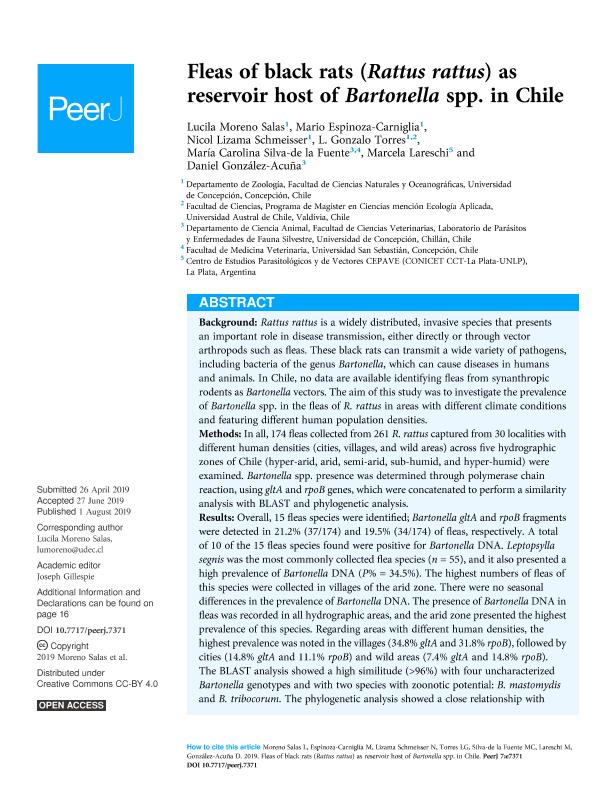Mostrar el registro sencillo del ítem
dc.contributor.author
Moreno Salas, Lucila
dc.contributor.author
Espinoza Carniglia, Mario Virgilio

dc.contributor.author
Lizama Schmeisser, Nicol
dc.contributor.author
Torres, L. Gonzalo
dc.contributor.author
Silva de la Fuente, María Carolina
dc.contributor.author
Lareschi, Marcela

dc.contributor.author
González Acuña, Daniel
dc.date.available
2021-01-05T13:53:13Z
dc.date.issued
2019-08
dc.identifier.citation
Moreno Salas, Lucila; Espinoza Carniglia, Mario Virgilio; Lizama Schmeisser, Nicol; Torres, L. Gonzalo; Silva de la Fuente, María Carolina; et al.; Fleas of black rats (Rattus rattus) as reservoir host of Bartonella spp. In Chile; PeerJ Inc.; PeerJ; 2019; 8; 8-2019
dc.identifier.issn
2167-8359
dc.identifier.uri
http://hdl.handle.net/11336/121480
dc.description.abstract
Rattus rattus is a widely distributed, invasive species that presentsan important role in disease transmission, either directly or through vectorarthropods such as fleas. These black rats can transmit a wide variety of pathogens, including bacteria of the genus Bartonella, which can cause diseases in humans and animals. In Chile, no data are available identifying fleas from synanthropic rodents as Bartonella vectors. The aim of this study was to investigate the prevalence of Bartonella spp. in the fleas of R. rattus in areas with different climate conditions and featuring different human population densities. In all, 174 fleas collected from 261 R. rattus captured from 30 localities with different human densities (cities, villages, and wild areas) across five hydrographic zones of Chile (hyper-arid, arid, semi-arid, sub-humid, and hyper-humid) were examined. Bartonella spp. presence was determined through polymerase chain reaction, using gltA and rpoB genes, which were concatenated to perform a similarity analysis with BLAST and phylogenetic analysis.Results: Overall, 15 fleas species were identified; Bartonella gltA and rpoB fragments were detected in 21.2% (37/174) and 19.5% (34/174) of fleas, respectively. A total of 10 of the 15 fleas species found were positive for Bartonella DNA. Leptopsylla segnis was the most commonly collected flea species (n = 55), and it also presented a high prevalence of Bartonella DNA (P% = 34.5%). The highest numbers of fleas of this species were collected in villages of the arid zone. There were no seasonal differences in the prevalence of Bartonella DNA. The presence of Bartonella DNA in fleas was recorded in all hydrographic areas, and the arid zone presented the highest prevalence of this species. Regarding areas with different human densities, the highest prevalence was noted in the villages (34.8% gltA and 31.8% rpoB), followed by cities (14.8% gltA and 11.1% rpoB) and wild areas (7.4% gltA and 14.8% rpoB). The BLAST analysis showed a high similitude (>96%) with four uncharacterized Bartonella genotypes and with two species with zoonotic potential: B. mastomydisand B. tribocorum. The phylogenetic analysis showed a close relationship withB. elizabethae and B. tribocorum. This is the first study to provide evidence of the presence of Bartonella in fleas of R. rattus in Chile, indicating that the villages and arid zone correspond to areas with higher infection risk.
dc.format
application/pdf
dc.language.iso
eng
dc.publisher
PeerJ Inc.
dc.rights
info:eu-repo/semantics/openAccess
dc.rights.uri
https://creativecommons.org/licenses/by-nc-sa/2.5/ar/
dc.subject
RATTUS
dc.subject
FLEAS
dc.subject
BARTONELLA
dc.subject
PUBLIC HEALTH
dc.subject.classification
Ecología

dc.subject.classification
Ciencias Biológicas

dc.subject.classification
CIENCIAS NATURALES Y EXACTAS

dc.subject.classification
Zoología, Ornitología, Entomología, Etología

dc.subject.classification
Ciencias Biológicas

dc.subject.classification
CIENCIAS NATURALES Y EXACTAS

dc.subject.classification
Otras Ciencias Naturales y Exactas

dc.subject.classification
Otras Ciencias Naturales y Exactas

dc.subject.classification
CIENCIAS NATURALES Y EXACTAS

dc.title
Fleas of black rats (Rattus rattus) as reservoir host of Bartonella spp. In Chile
dc.type
info:eu-repo/semantics/article
dc.type
info:ar-repo/semantics/artículo
dc.type
info:eu-repo/semantics/publishedVersion
dc.date.updated
2020-11-20T17:16:55Z
dc.journal.volume
2019
dc.journal.number
8
dc.journal.pais
Estados Unidos

dc.description.fil
Fil: Moreno Salas, Lucila. Universidad de Concepción. Facultad de Ciencias Naturales y Oceanografía. Departamento de Zoología; Chile
dc.description.fil
Fil: Espinoza Carniglia, Mario Virgilio. Universidad de Concepción. Facultad de Ciencias Naturales y Oceanografía. Departamento de Zoología; Chile. Consejo Nacional de Investigaciones Científicas y Técnicas. Centro Científico Tecnológico Conicet - La Plata. Centro de Estudios Parasitológicos y de Vectores. Universidad Nacional de La Plata. Facultad de Ciencias Naturales y Museo. Centro de Estudios Parasitológicos y de Vectores; Argentina
dc.description.fil
Fil: Lizama Schmeisser, Nicol. Universidad de Concepción. Facultad de Ciencias Naturales y Oceanografía. Departamento de Zoología; Chile
dc.description.fil
Fil: Torres, L. Gonzalo. Universidad de Concepción. Facultad de Ciencias Naturales y Oceanografía. Departamento de Zoología; Chile. Universidad Austral de Chile; Chile
dc.description.fil
Fil: Silva de la Fuente, María Carolina. Universidad de Concepción; Chile. Universidad San Sebastian.; Chile
dc.description.fil
Fil: Lareschi, Marcela. Consejo Nacional de Investigaciones Científicas y Técnicas. Centro Científico Tecnológico Conicet - La Plata. Centro de Estudios Parasitológicos y de Vectores. Universidad Nacional de La Plata. Facultad de Ciencias Naturales y Museo. Centro de Estudios Parasitológicos y de Vectores; Argentina
dc.description.fil
Fil: González Acuña, Daniel. Universidad de Concepción; Chile
dc.journal.title
PeerJ
dc.relation.alternativeid
info:eu-repo/semantics/altIdentifier/url/https://peerj.com/articles/7371
dc.relation.alternativeid
info:eu-repo/semantics/altIdentifier/doi/http://dx.doi.org/10.7717/peerj.7371
dc.relation.alternativeid
info:eu-repo/semantics/altIdentifier/url/https://www.ncbi.nlm.nih.gov/pmc/articles/PMC6679904/
Archivos asociados
